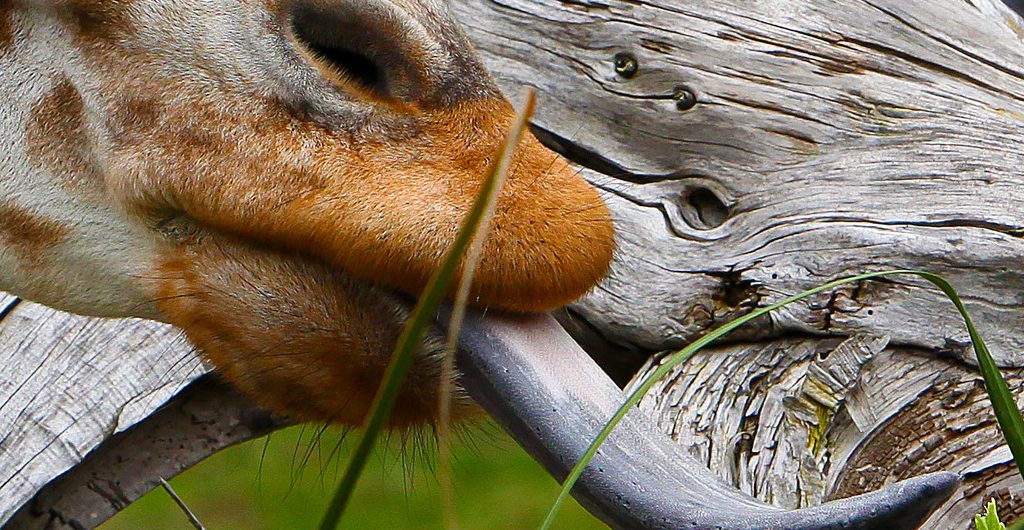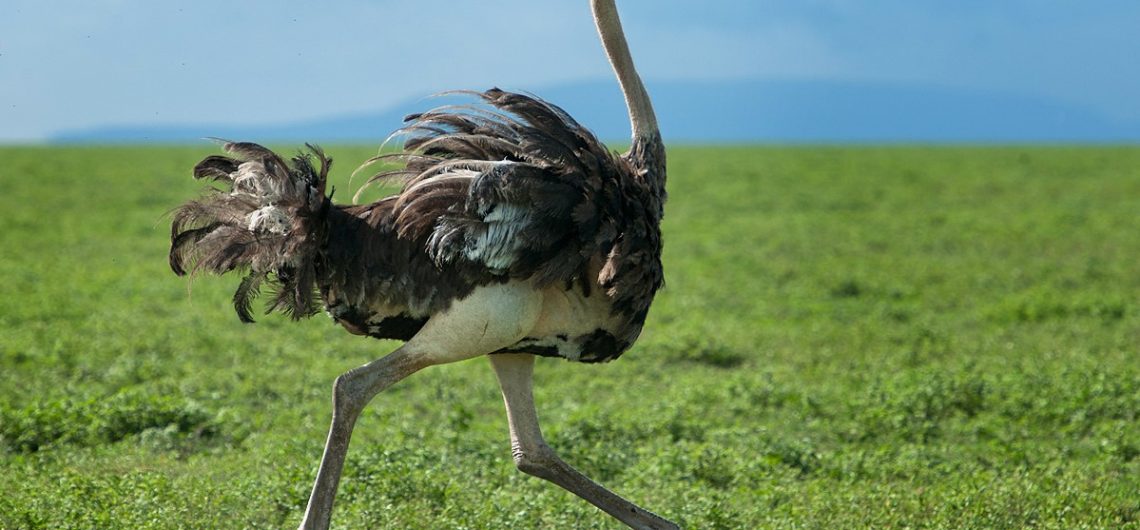-
01of 10
Giraffes Have Blue Tongues
/GettyImages-520821336-5923bfd73df78cf5fad9db9f.jpg?w=748&ssl=1)
••• Already a bizarre-looking creature, the giraffe’s strange appearance is compounded by the color of its tongue. There is a reason for its blue-black hue, however. Giraffes use their tongues to strip leaves from the tallest trees, and the high melanin content helps to prevent them from getting sunburned. This is just one of the giraffe’s many special adaptations. Blood is pumped up their famously long necks by a uniquely powerful system of valves and veins. When the giraffe lowers its head to drink, the same system prevents the blood from rushing downwards and causing a sudden loss of consciousness. Amazingly, when female giraffes give birth the baby drops some six feet to the ground – but is able to stand up, walk and even run shortly afterwards.
-
02of 10
Ostriches Can Sprint Over 45 Miles an Hour
/GettyImages-530231048-5923c0513df78cf5fad9dc75.jpg?w=748&ssl=1)
••• As well as being the largest bird on Earth, the ostrich is also the fastest two-legged runner in the Animal Kingdom. On average, ostriches can sprint at speeds of up to 45 mph/ 72 kmph, while records show that the fastest ostriches can achieve short bursts of up to 60 mph/ 96.6 kmph. They are also the world’s strongest bird. An ostrich can easily support the weight of a man, and their enormous eggs are capable of withstanding great pressure. In some areas of Africa, ostriches are used for racing. You can experience this for yourself in Oudtshoorn, an ostrich-farming town in South Africa‘s Karoo desert. Be careful though – ostriches have famously volatile temperaments, and are capable of inflicting serious damage. An ostrich can easily kick a grown man to death – an ability often used on predators in the wild.
-
03of 10
The Hippo is One of Africa’s Most Deadly Animals
/GettyImages-533747154-5923c0f85f9b58f4c0f1f97f.jpg?w=748&ssl=1)
••• Despite having a mostly herbivorous diet, hippos are often cited as the most dangerous of all African animals. Male hippos fiercely protect their section of the river, and will often attack those that unwittingly encroach upon their territory. Females are also quick to attack anyone that comes in between them and their calves. Hippos may look slow, but they can achieve speeds of around 20 mph/ 30 kmph on land. Both males and females have powerful jaws with enlarged canines and incisors, sometimes called tusks. The male hippo’s canines can reach up to 19.6 inches/ 50 centimeters in length. Other amazing hippo adaptations include their ability to hold their breath for over five minutes, and their skin, which produces its own natural sunscreen – a useful defence against the relentless African sun.
-
04of 10
Hyenas are More Closely Related to Cats than Dogs
/GettyImages-526324078-5923c1a53df78cf5fad9df8c.jpg?w=748&ssl=1)
••• Hyenas are more closely related to cats than dogs. They live in matriarchal clans, with some groups numbering over 70 members. Hyena cubs are usually born in pairs, and if they are the same sex, they may try to kill each other. Although hyenas are known as scavengers, they also regularly hunt live prey. Hyena dung is white when dry because of the large amount of calcium found in the bones that they eat. A team of researchers excavating a cave near Johannesburg, South Africa, discovered five human hairs preserved in fossilized hyena dung. Thought to be at least 200,000 years old, the hairs exceeded the previous record for the oldest known human hair by more than 190,000 years. Striped hyenas are born with adult markings, closed eyes, and small ears. Spotted hyenas are born with eyes wide open and teeth intact.
-
05of 10
Lions Sleep for 20 Hours a Day
/GettyImages-5336212821-5923c2993df78cf5fad9e0a8.jpg?w=748&ssl=1)
••• The African lion has been admired by man for its beauty and strength for thousands of years. It is one of the most exciting animals to see on safari. However, you’re more likely to see one sleeping than hunting because lions rest for an average of 20 hours every day. Because they hunt primarily at night, they do most of their sleeping during daylight hours. In this, lions are similar to many other cat species. However, they are also unique in many ways. They are the only cats with marked differences between males and females, and unlike house cats, they cannot purr. They are also the only cats to live in large family groups, or prides. Living, hunting and raising cubs together is a survival tactic that allows for greater hunting success and a higher rate of infant survival.
-
06of 10
An Elephant Calf Often Sucks its Trunk for Comfort
/GettyImages-541043026-5923c3be3df78cf5fad9e400.jpg?w=748&ssl=1)
••• Elephant calves are amongst the most adorable of all baby safari animals, with their tiny trunks and light covering of fine orange fuzz. Elephant babies are often seen sucking their trunks, in the same way that a human baby might suck its thumb. This is a natural reflex, and a source of comfort in between feeding sessions. Trunk-sucking is sometimes seen in older elephants, too, especially when they are uncertain of their surroundings. Of course, an elephant’s trunk is more than a glorified pacifier. With more than 40,000 different muscles, it is incredibly dextrous. It is used to breathe, smell, touch, drink, eat and communicate. It can pull down trees, or be used to pick up something as delicate as a tiny twig. When crossing deep rivers, and elephant can even use its trunk as a built-in snorkel.
-
07of 10
Black Mamba Venom Can Kill in a Matter of Hours
/GettyImages-98220239-5923c4343df78cf5fad9e5f1.jpg?w=748&ssl=1)
••• Undoubtedly the most feared of all Africa’s dangerous snake species, the black mamba’s venom comprises a lethal mix of neurotoxins and cardiotoxins. If cornered, the snake can deliver several bites in quick succession – although even a single bite is enough to cause a human to collapse within 45 minutes. Without antivenom, death occurs within 15 hours and the mortality rate is 100%. Ultimately, death is caused by asphyxiation, respiratory failure or complete cardiovascular collapse. Black mambas have a reputation for aggression, but the truth is that like most snakes, they prefer to avoid confrontation where possible. Despite their name, they are rarely black, often appearing brown, grey or olive green instead.
-
08of 10
Crocodiles Have Been Around for Over 200 Million Years
/GettyImages-694026693-5923c4935f9b58f4c0f20312.jpg?w=748&ssl=1)
••• Crocodiles have roamed the Earth for approximately 200 million years. After surviving the catastrophe that caused the mass extinction of the dinosaurs, they continued to evolve into the awe-inspiring predators we know today. Nile crocodiles can hold their breath underwater for over 10 minutes, and can go for months at a time without food. Their armor-like skin protects them from injury, and their immune system is so well-developed that they can feed on decaying flesh without getting sick. They have one of the strongest bite forces on record, and can move at lightning fast speeds during an ambush. Despite their fearsome reputation, Nile crocodiles are surprisingly dedicated parents, guarding their eggs fiercely during incubation.
Continue to 9 of 10 below. -
09of 10
Dung Beetles Use the Milky Way as a Compass
/GettyImages-80278569-5923c4ff5f9b58f4c0f20369.jpg?w=748&ssl=1)
••• African dung beetles are amazing creatures. They spend their lives gathering the faeces of other safari animals and rolling them into great balls that can exceed their own body weight by up to 10 times. The beetles roll their balls in a straight line, despite any obstacles that may stand in their way. They bury the dung and use it as a larder, or as a nutritional nest for their eggs. Scientists have discovered that dung beetles use the stars to navigate, and are capable of doing so even when only the glow from the Milky Way or other bright stars is visible. One African species can even navigate by moonlight alone – making these the only insects known to orientate themselves using the galaxy. According to research, dung beetles prefer omnivore faeces to herbivore faeces.
-
10of 10
Pangolins Retract Their Tongues Into a Special Chest Cavity
/GettyImages-148307260-5923c7215f9b58f4c0f206bf.jpg?w=748&ssl=1)
••• A rare sight on any safari, pangolins are as fascinating as they are elusive. Pangolins are toothless, and instead have strong, sticky tongues designed for lapping up ants. When fully extended, the pangolin’s tongue is longer than its head and body combined. When not in use, it is stored in a special cavity in the animal’s chest. Pangolins are nocturnal, and sleep curled up to protect themselves from predators. Their bodies are covered in hard scales, made from keratin – the same substance that human fingernails are made from. Unfortunately, its body parts are highly sought after in Asia, both for consumption and for use in traditional medicine. All eight pangolin species are targeted for wildlife trafficking, and four are either endangered or critically endangered.
Giraffes Have Blue Tongues
/GettyImages-520821336-5923bfd73df78cf5fad9db9f.jpg?w=748&ssl=1)
Already a bizarre-looking creature, the giraffe’s strange appearance is compounded by the color of its tongue. There is a reason for its blue-black hue, however. Giraffes use their tongues to strip leaves from the tallest trees, and the high melanin content helps to prevent them from getting sunburned. This is just one of the giraffe’s many special adaptations. Blood is pumped up their famously long necks by a uniquely powerful system of valves and veins. When the giraffe lowers its head to drink, the same system prevents the blood from rushing downwards and causing a sudden loss of consciousness. Amazingly, when female giraffes give birth the baby drops some six feet to the ground – but is able to stand up, walk and even run shortly afterwards.











